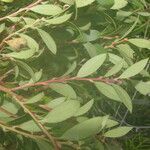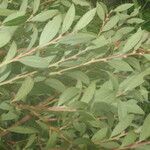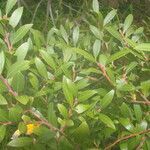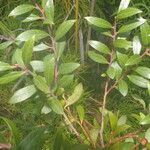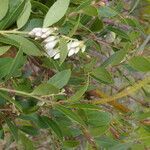Shrubs or small trees (0.5-) 1-3 (-4) m tall, often compact and densely bushy with stiff, rigid, glabrous to densely puberulent branchlets. Leaves pinnately veined, persistent, glabrous or with scattered glandular trichomes be-neath and moderately puberulous along the midvein; shallowly serrulate with teeth mostly (1-)2-4 mm apart, each tooth often tipped with a darkish glandular callosity, marginally callose thickened, (1.0-) 1.5-3 (-4.6) cm long, 5-12(-18) mm wide, usually 2-3 times as long as wide, mostly narrowly to broadly elliptic, occasionally oblong, usually tapering to an acute apex and base; petioles 1.5-3 mm long, glabrous or puberulent. Inflorescence an axillary raceme, mostly 1-4 cm long; rachis sharply angled, puberulent; bracts scarious, slightly puberulent or ciliate, ovate to oblong, 2-3 mm long; pedicels puberulent, 1-2 mm long; bractlets subopposite, ovate to oblong, scarious, ciliate but otherwise glabrous, entire to sparingly irregularly and minutely toothed, 1.5-3 mm long. Flowers with the hypanthium sharply articulated with the pedicel, campanulate, glabrous, 1-1.6 mm long; calyx limb 0.5-0.7 mm long, the lobes 4, deltoid to broadly ovate, apically ciliate but otherwise glabrous, 0.8-1.5 mm long; corolla cylindric, 5-7.5 mm long, glabrous, creamy white with tinges of red or pink, the tube 4-6 mm long, 3-4 mm in diameter, the corolla lobes 4, oblong, 1-1.7 mm long; stamens 8, the filaments 3-4 mm long, ciliate, the anthers granular papillate, the thecae 1.5-1.8 mm long, each sac with a tubule and 2 spurs, the tubule 1.2-1.8 mm long dehiscing by an introrse cleft 0.5-0.7 mm long, the spurs slender, horn-like, ascendent, originating from near the apex of the thecae, 0.2-0.6 mm long. Berry reddish to blackish purple at maturity, globose, 5-6 mm in diameter.
More
A tall evergreen shrub. It grows 1.2 m tall. It has stiff, ridged branches. It forms a compact bushy shrub. The young stems can be red or purple. The leaves are sword shaped and 4-8 cm long. They have shallow teeth. The flowers are cylinder shaped and 5-8 mm long. They are white with tinges of red. The fruit are round and 5-8 mm across. They are green when young but turn dark red then black as they ripen.
